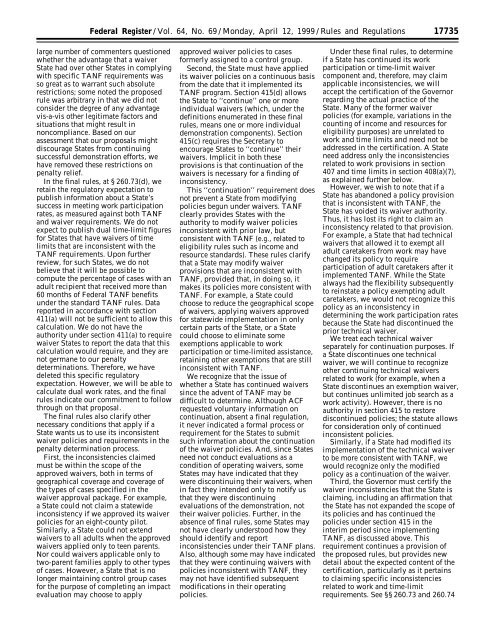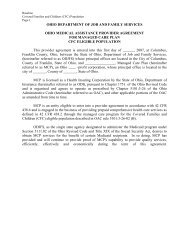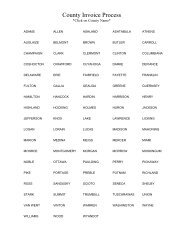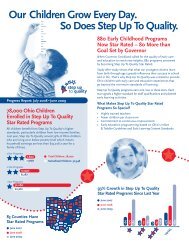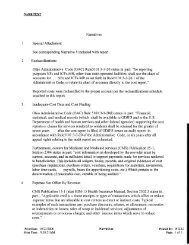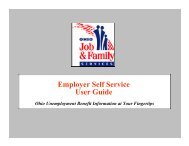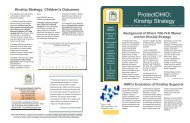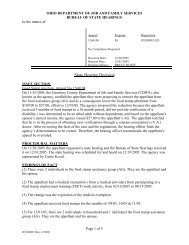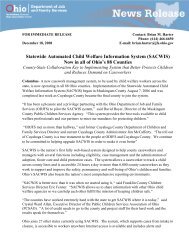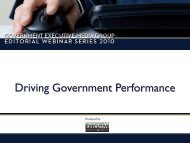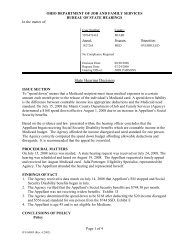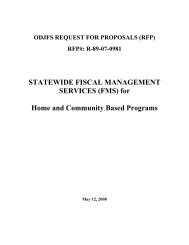Final TANF Rule as published in the Federal Register 4/12/1999
Final TANF Rule as published in the Federal Register 4/12/1999
Final TANF Rule as published in the Federal Register 4/12/1999
Create successful ePaper yourself
Turn your PDF publications into a flip-book with our unique Google optimized e-Paper software.
<strong>Federal</strong> <strong>Register</strong> / Vol. 64, No. 69 / Monday, April <strong>12</strong>, <strong>1999</strong> / <strong>Rule</strong>s and Regulations<br />
large number of commenters questioned<br />
whe<strong>the</strong>r <strong>the</strong> advantage that a waiver<br />
State had over o<strong>the</strong>r States <strong>in</strong> comply<strong>in</strong>g<br />
with specific <strong>TANF</strong> requirements w<strong>as</strong><br />
so great <strong>as</strong> to warrant such absolute<br />
restrictions; some noted <strong>the</strong> proposed<br />
rule w<strong>as</strong> arbitrary <strong>in</strong> that we did not<br />
consider <strong>the</strong> degree of any advantage<br />
vis-a-vis o<strong>the</strong>r legitimate factors and<br />
situations that might result <strong>in</strong><br />
noncompliance. B<strong>as</strong>ed on our<br />
<strong>as</strong>sessment that our proposals might<br />
discourage States from cont<strong>in</strong>u<strong>in</strong>g<br />
successful demonstration efforts, we<br />
have removed <strong>the</strong>se restrictions on<br />
penalty relief.<br />
In <strong>the</strong> f<strong>in</strong>al rules, at § 260.73(d), we<br />
reta<strong>in</strong> <strong>the</strong> regulatory expectation to<br />
publish <strong>in</strong>formation about a State’s<br />
success <strong>in</strong> meet<strong>in</strong>g work participation<br />
rates, <strong>as</strong> me<strong>as</strong>ured aga<strong>in</strong>st both <strong>TANF</strong><br />
and waiver requirements. We do not<br />
expect to publish dual time-limit figures<br />
for States that have waivers of time<br />
limits that are <strong>in</strong>consistent with <strong>the</strong><br />
<strong>TANF</strong> requirements. Upon fur<strong>the</strong>r<br />
review, for such States, we do not<br />
believe that it will be possible to<br />
compute <strong>the</strong> percentage of c<strong>as</strong>es with an<br />
adult recipient that received more than<br />
60 months of <strong>Federal</strong> <strong>TANF</strong> benefits<br />
under <strong>the</strong> standard <strong>TANF</strong> rules. Data<br />
reported <strong>in</strong> accordance with section<br />
411(a) will not be sufficient to allow this<br />
calculation. We do not have <strong>the</strong><br />
authority under section 411(a) to require<br />
waiver States to report <strong>the</strong> data that this<br />
calculation would require, and <strong>the</strong>y are<br />
not germane to our penalty<br />
determ<strong>in</strong>ations. Therefore, we have<br />
deleted this specific regulatory<br />
expectation. However, we will be able to<br />
calculate dual work rates, and <strong>the</strong> f<strong>in</strong>al<br />
rules <strong>in</strong>dicate our commitment to follow<br />
through on that proposal.<br />
The f<strong>in</strong>al rules also clarify o<strong>the</strong>r<br />
necessary conditions that apply if a<br />
State wants us to use its <strong>in</strong>consistent<br />
waiver policies and requirements <strong>in</strong> <strong>the</strong><br />
penalty determ<strong>in</strong>ation process.<br />
First, <strong>the</strong> <strong>in</strong>consistencies claimed<br />
must be with<strong>in</strong> <strong>the</strong> scope of <strong>the</strong><br />
approved waivers, both <strong>in</strong> terms of<br />
geographical coverage and coverage of<br />
<strong>the</strong> types of c<strong>as</strong>es specified <strong>in</strong> <strong>the</strong><br />
waiver approval package. For example,<br />
a State could not claim a statewide<br />
<strong>in</strong>consistency if we approved its waiver<br />
policies for an eight-county pilot.<br />
Similarly, a State could not extend<br />
waivers to all adults when <strong>the</strong> approved<br />
waivers applied only to teen parents.<br />
Nor could waivers applicable only to<br />
two-parent families apply to o<strong>the</strong>r types<br />
of c<strong>as</strong>es. However, a State that is no<br />
longer ma<strong>in</strong>ta<strong>in</strong><strong>in</strong>g control group c<strong>as</strong>es<br />
for <strong>the</strong> purpose of complet<strong>in</strong>g an impact<br />
evaluation may choose to apply<br />
approved waiver policies to c<strong>as</strong>es<br />
formerly <strong>as</strong>signed to a control group.<br />
Second, <strong>the</strong> State must have applied<br />
its waiver policies on a cont<strong>in</strong>uous b<strong>as</strong>is<br />
from <strong>the</strong> date that it implemented its<br />
<strong>TANF</strong> program. Section 415(d) allows<br />
<strong>the</strong> State to ‘‘cont<strong>in</strong>ue’’ one or more<br />
<strong>in</strong>dividual waivers (which, under <strong>the</strong><br />
def<strong>in</strong>itions enumerated <strong>in</strong> <strong>the</strong>se f<strong>in</strong>al<br />
rules, means one or more <strong>in</strong>dividual<br />
demonstration components). Section<br />
415(c) requires <strong>the</strong> Secretary to<br />
encourage States to ‘‘cont<strong>in</strong>ue’’ <strong>the</strong>ir<br />
waivers. Implicit <strong>in</strong> both <strong>the</strong>se<br />
provisions is that cont<strong>in</strong>uation of <strong>the</strong><br />
waivers is necessary for a f<strong>in</strong>d<strong>in</strong>g of<br />
<strong>in</strong>consistency.<br />
This ‘‘cont<strong>in</strong>uation’’ requirement does<br />
not prevent a State from modify<strong>in</strong>g<br />
policies begun under waivers. <strong>TANF</strong><br />
clearly provides States with <strong>the</strong><br />
authority to modify waiver policies<br />
<strong>in</strong>consistent with prior law, but<br />
consistent with <strong>TANF</strong> (e.g., related to<br />
eligibility rules such <strong>as</strong> <strong>in</strong>come and<br />
resource standards). These rules clarify<br />
that a State may modify waiver<br />
provisions that are <strong>in</strong>consistent with<br />
<strong>TANF</strong>, provided that, <strong>in</strong> do<strong>in</strong>g so, it<br />
makes its policies more consistent with<br />
<strong>TANF</strong>. For example, a State could<br />
choose to reduce <strong>the</strong> geographical scope<br />
of waivers, apply<strong>in</strong>g waivers approved<br />
for statewide implementation <strong>in</strong> only<br />
certa<strong>in</strong> parts of <strong>the</strong> State, or a State<br />
could choose to elim<strong>in</strong>ate some<br />
exemptions applicable to work<br />
participation or time-limited <strong>as</strong>sistance,<br />
reta<strong>in</strong><strong>in</strong>g o<strong>the</strong>r exemptions that are still<br />
<strong>in</strong>consistent with <strong>TANF</strong>.<br />
We recognize that <strong>the</strong> issue of<br />
whe<strong>the</strong>r a State h<strong>as</strong> cont<strong>in</strong>ued waivers<br />
s<strong>in</strong>ce <strong>the</strong> advent of <strong>TANF</strong> may be<br />
difficult to determ<strong>in</strong>e. Although ACF<br />
requested voluntary <strong>in</strong>formation on<br />
cont<strong>in</strong>uation, absent a f<strong>in</strong>al regulation,<br />
it never <strong>in</strong>dicated a formal process or<br />
requirement for <strong>the</strong> States to submit<br />
such <strong>in</strong>formation about <strong>the</strong> cont<strong>in</strong>uation<br />
of <strong>the</strong> waiver policies. And, s<strong>in</strong>ce States<br />
need not conduct evaluations <strong>as</strong> a<br />
condition of operat<strong>in</strong>g waivers, some<br />
States may have <strong>in</strong>dicated that <strong>the</strong>y<br />
were discont<strong>in</strong>u<strong>in</strong>g <strong>the</strong>ir waivers, when<br />
<strong>in</strong> fact <strong>the</strong>y <strong>in</strong>tended only to notify us<br />
that <strong>the</strong>y were discont<strong>in</strong>u<strong>in</strong>g<br />
evaluations of <strong>the</strong> demonstration, not<br />
<strong>the</strong>ir waiver policies. Fur<strong>the</strong>r, <strong>in</strong> <strong>the</strong><br />
absence of f<strong>in</strong>al rules, some States may<br />
not have clearly understood how <strong>the</strong>y<br />
should identify and report<br />
<strong>in</strong>consistencies under <strong>the</strong>ir <strong>TANF</strong> plans.<br />
Also, although some may have <strong>in</strong>dicated<br />
that <strong>the</strong>y were cont<strong>in</strong>u<strong>in</strong>g waivers with<br />
policies <strong>in</strong>consistent with <strong>TANF</strong>, <strong>the</strong>y<br />
may not have identified subsequent<br />
modifications <strong>in</strong> <strong>the</strong>ir operat<strong>in</strong>g<br />
policies.<br />
17735<br />
Under <strong>the</strong>se f<strong>in</strong>al rules, to determ<strong>in</strong>e<br />
if a State h<strong>as</strong> cont<strong>in</strong>ued its work<br />
participation or time-limit waiver<br />
component and, <strong>the</strong>refore, may claim<br />
applicable <strong>in</strong>consistencies, we will<br />
accept <strong>the</strong> certification of <strong>the</strong> Governor<br />
regard<strong>in</strong>g <strong>the</strong> actual practice of <strong>the</strong><br />
State. Many of <strong>the</strong> former waiver<br />
policies (for example, variations <strong>in</strong> <strong>the</strong><br />
count<strong>in</strong>g of <strong>in</strong>come and resources for<br />
eligibility purposes) are unrelated to<br />
work and time limits and need not be<br />
addressed <strong>in</strong> <strong>the</strong> certification. A State<br />
need address only <strong>the</strong> <strong>in</strong>consistencies<br />
related to work provisions <strong>in</strong> section<br />
407 and time limits <strong>in</strong> section 408(a)(7),<br />
<strong>as</strong> expla<strong>in</strong>ed fur<strong>the</strong>r below.<br />
However, we wish to note that if a<br />
State h<strong>as</strong> abandoned a policy provision<br />
that is <strong>in</strong>consistent with <strong>TANF</strong>, <strong>the</strong><br />
State h<strong>as</strong> voided its waiver authority.<br />
Thus, it h<strong>as</strong> lost its right to claim an<br />
<strong>in</strong>consistency related to that provision.<br />
For example, a State that had technical<br />
waivers that allowed it to exempt all<br />
adult caretakers from work may have<br />
changed its policy to require<br />
participation of adult caretakers after it<br />
implemented <strong>TANF</strong>. While <strong>the</strong> State<br />
always had <strong>the</strong> flexibility subsequently<br />
to re<strong>in</strong>state a policy exempt<strong>in</strong>g adult<br />
caretakers, we would not recognize this<br />
policy <strong>as</strong> an <strong>in</strong>consistency <strong>in</strong><br />
determ<strong>in</strong><strong>in</strong>g <strong>the</strong> work participation rates<br />
because <strong>the</strong> State had discont<strong>in</strong>ued <strong>the</strong><br />
prior technical waiver.<br />
We treat each technical waiver<br />
separately for cont<strong>in</strong>uation purposes. If<br />
a State discont<strong>in</strong>ues one technical<br />
waiver, we will cont<strong>in</strong>ue to recognize<br />
o<strong>the</strong>r cont<strong>in</strong>u<strong>in</strong>g technical waivers<br />
related to work (for example, when a<br />
State discont<strong>in</strong>ues an exemption waiver,<br />
but cont<strong>in</strong>ues unlimited job search <strong>as</strong> a<br />
work activity). However, <strong>the</strong>re is no<br />
authority <strong>in</strong> section 415 to restore<br />
discont<strong>in</strong>ued policies; <strong>the</strong> statute allows<br />
for consideration only of cont<strong>in</strong>ued<br />
<strong>in</strong>consistent policies.<br />
Similarly, if a State had modified its<br />
implementation of <strong>the</strong> technical waiver<br />
to be more consistent with <strong>TANF</strong>, we<br />
would recognize only <strong>the</strong> modified<br />
policy <strong>as</strong> a cont<strong>in</strong>uation of <strong>the</strong> waiver.<br />
Third, <strong>the</strong> Governor must certify <strong>the</strong><br />
waiver <strong>in</strong>consistencies that <strong>the</strong> State is<br />
claim<strong>in</strong>g, <strong>in</strong>clud<strong>in</strong>g an affirmation that<br />
<strong>the</strong> State h<strong>as</strong> not expanded <strong>the</strong> scope of<br />
its policies and h<strong>as</strong> cont<strong>in</strong>ued <strong>the</strong><br />
policies under section 415 <strong>in</strong> <strong>the</strong><br />
<strong>in</strong>terim period s<strong>in</strong>ce implement<strong>in</strong>g<br />
<strong>TANF</strong>, <strong>as</strong> discussed above. This<br />
requirement cont<strong>in</strong>ues a provision of<br />
<strong>the</strong> proposed rules, but provides new<br />
detail about <strong>the</strong> expected content of <strong>the</strong><br />
certification, particularly <strong>as</strong> it perta<strong>in</strong>s<br />
to claim<strong>in</strong>g specific <strong>in</strong>consistencies<br />
related to work and time-limit<br />
requirements. See §§ 260.73 and 260.74


